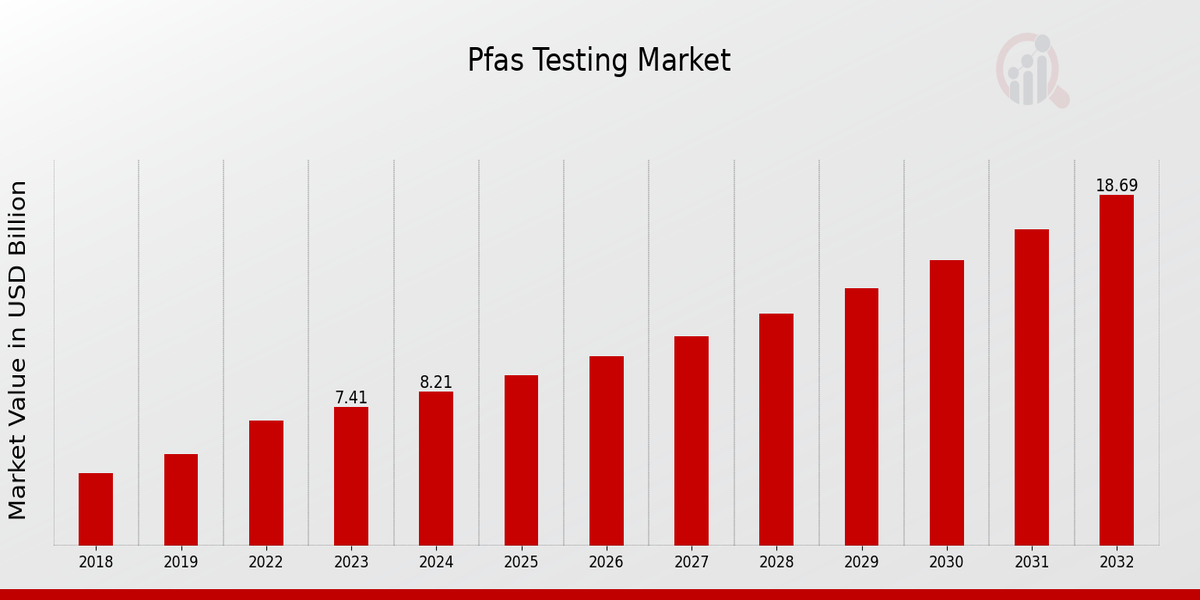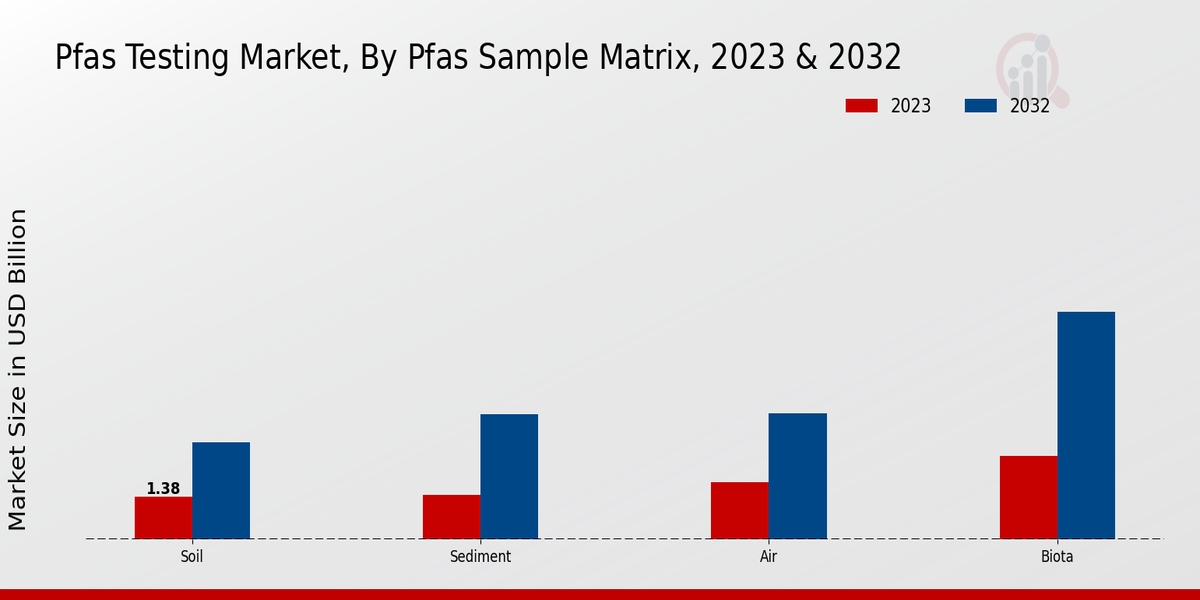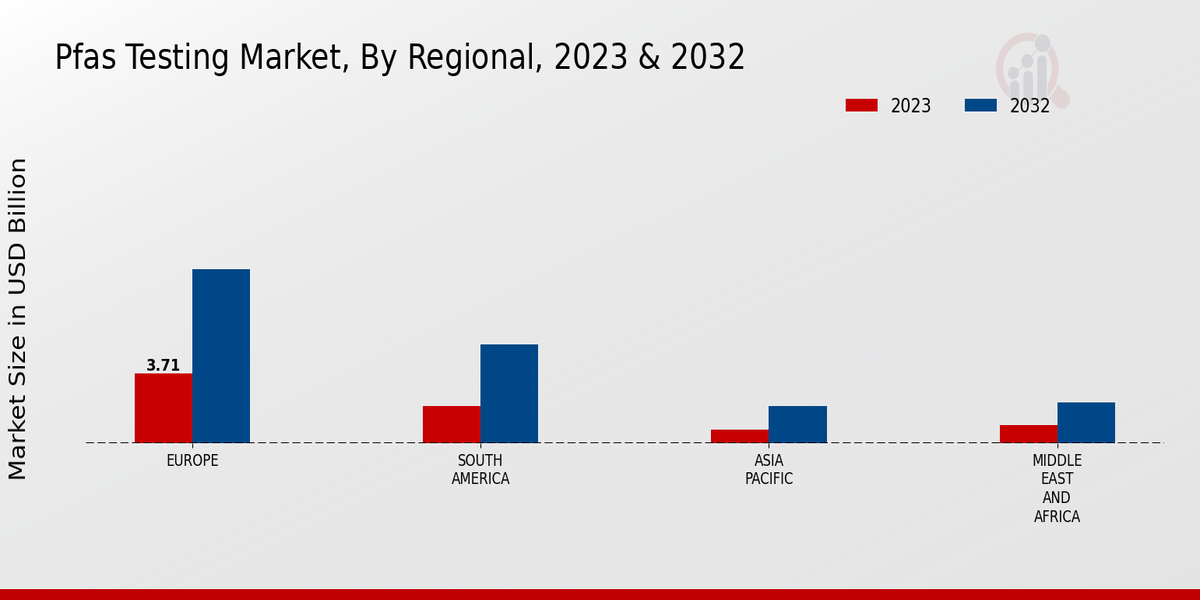Global PFAS Testing Market Overview
The PFAS Testing Market Size was estimated at 9.09 (USD Billion) in 2024. The PFAS Testing Industry is expected to grow from 10.08 (USD Billion) in 2025 to 25.43 (USD Billion) by 2034. The PFAS Testing MarketCAGR (growth rate) is expected to be around 10.83% during the forecast period (2025 - 2034).
Key PFAS Testing Market Trends Highlighted
Increased environmental awareness and stringent regulations drive the growth of the PFAS testing market. Governments worldwide are implementing policies to limit PFAS exposure, leading to a surge in demand for testing services. The market also benefits from technological advancements in analytical techniques, enabling more accurate and efficient PFAS detection.Key market drivers include the identification of novel PFAS compounds, expanding their known environmental and health impacts, and growing concerns over their presence in various consumer products. Opportunities for market expansion lie in developing innovative PFAS testing methods and expanding testing capabilities to detect a broader range of these emerging contaminants.
Source: Primary Research, Secondary Research, MRFR Database and Analyst Review
PFAS Testing MarketDrivers
Increasing Awareness of PFAS Contamination
PFAS, which stands for perfluoroalkyl and polyfluoroalkyl substances, belongs to the group of man-made chemicals, the first of which appeared at the beginning of the 1940s. Most of the chemicals from the given group are difficult to decompose. They persist in the environment, and can accumulate in the human organism, threatening human health. In the course of the recent few years, people have become more aware of the threats associated with PFAS presence in the environment.Consequently, the demand for the relevant tests has improved dramatically. The PFAS Testing MarketIndustry is expected to expand even more on account of the increasingly high rates of PFAS contamination that are likely to be registered in the course of the following few years.
Government Regulations on PFAS
There are multiple PFAS testing drivers. The main one, however, is recognized by everyone: government regulations. Governments across the globe are increasingly regulating the substances. For instance, in the United States, the Environmental Protection Agency has set the drinking water Health Advisory levels for PFAS emissions. In addition, the EPA has been actively working on developing new PFAS discharge regulations to limit the releases from industrial sources.In the European Union, the corresponding body, the European Chemicals Agency, has already proposed the possible restrictions. Companies are taking measures to comply with the new regulations, such as initiating and effectively implementing PFAS testing.
Technological Advancements in PFAS Testing
Technological advancements are improving the ways of PFAS testing, making it faster, cheaper, and more accurate. At the same time, this is an opportunity for companies and people to carry out testing without much hassle. Moreover, new methods of PFAS testing were a great way of highlighting the new sources of PFAS contamination. It is likely that the enhancement of existing and the development of new technological ways will lead to the continuous growth of the PFAS Testing Market Industry.
PFAS Testing Market Segment Insights
PFAS Testing Market Pfas Sample Matrix Insights
The PFAS Testing Market is segmented based on PFAS Sample Matrix into Water, Soil, Sediment, Air, and Biota. Water held the largest market share of around 43.2% in 2023, and it is likely to grow at a CAGR of 10.5% during the forecast period. The growth of the water segment can be attributed to the increasing demand for water quality testing, as there is a growing concern about water contamination. The Soil segment is expected to grow at a significant rate in the forecast period as the awareness about soil contamination and the requirement for soil remediation is increasing.The Sediment segment is likely to grow at a steady rate in the forecast period as the demand for sediment testing is increasing because of the growth in construction activities and the need for environmental impact assessment. The Air segment is likely to grow at a moderate pace in the forecast period as the pollution in the air is increasing as well as the need for air quality monitoring. The Biota segment is expected to grow at a slower pace in the forecast period as the concern with the PFAS effect on human health and the environment is increasing.Thus, the PFAS Testing market is likely to boom in the forecast period. The main driving factor for the growth of the market is the increase in the demand for PFAS testing services due to the increasing concern about PFAS contamination. The market is also driven by the increase in awareness about the impact of PFAS on health and the environment. Not only the growth of this market is driven by the constant demand for PFAS testing products and services but also by increases in the research activities that are related to the PFAS.
Source: Primary Research, Secondary Research, MRFR Database and Analyst Review
PFAS Testing MarketAnalysis Technique Insights
The market for tools and testing kits used to assess the presence of PFAS is huge and market value for the same is constantly increasing. Analysis Technique is of paramount significance here, with the dominant methods being LC-MS/MS, GC-MS, Immunoassay, and HPLC. LC-MS/MS leads in this market mainly because it is highly sensitive and precise when it comes to tracing PFAS compounds. GC-MS is another popular method that displays high specificity and identifies a wide spectrum of PFAS. Immunoassay is making strides, too, as it is less expensive and takes less time than the methods mentioned above.HPLC traces particular PFAS compounds in water and soil samples. The Analysis Technique segment is growing and will continue on the same path as the market is ready for advances concerning testing the methods and new ways of analyzing.
PFAS Testing Market Application Insights
The PFAS Testing Marketis segmented into various applications, including environmental monitoring, health and safety, food and agriculture, and consumer products. The environmental monitoring segment holds a significant market share due to the increasing demand for Pfas testing in water, soil, and air to ensure environmental safety and compliance with regulations. The health and safety segment are also witnessing significant growth due to the rising awareness about the potential health hazards associated with Pfas exposure. The food and agriculture segment are expected to grow steadily as Pfas testing becomes essential for ensuring the safety of food products and agricultural inputs.The consumer products segment is anticipated to show moderate growth, driven by the demand for Pfas testing in various consumer products such as textiles, cosmetics, and packaging materials. Overall, the PFAS Testing Marketis expected to witness robust growth in the coming years, driven by increasing environmental concerns, health and safety regulations, and advancements in testing technologies.
PFAS Testing Market End User Insights
The PFAS Testing Marketis segmented based on end user into government agencies, environmental consultants, industrial companies, and research institutions. Among these segments, industrial companies held the largest market share in 2023, owing to the increasing demand for PFAS testing services from industries such as manufacturing, electronics, and automotive. Government agencies are also expected to contribute significantly to the market growth, as they are responsible for regulating and monitoring PFAS levels in the environment.Environmental consultants provide PFAS testing services to various clients, including industrial companies, government agencies, and individuals. Research institutions are involved in developing new PFAS testing methods and technologies.
PFAS Testing Market Pfas Type Insights
The PFAS Testing Market by Pfas Type is segmented into Perfluoroalkyl Acids (PFAAs), Perfluoroalkyl Ether Carboxylic Acids (PFECAs), Perfluoroalkyl Sulfonamides (PFASAs), and Perfluoroalkyl Sulfonates (PFASs). The Perfluoroalkyl Acids (PFAAs) segment held the largest market share in 2023, owing to extensive usage in various industrial applications such as the production of coatings, paints, and adhesives. Perfluoroalkyl Ether Carboxylic Acids (PFECAs) segment is anticipated to exhibit the highest CAGR during the forecast period, owing to its increasing demand in the electronics industry for manufacturing semiconductors and printed circuit boards.Perfluoroalkyl Sulfonamides (PFASAs) segment is projected to witness steady growth over the forecast period due to its applications in the oil and gas industry as surfactants and corrosion inhibitors. The Perfluoroalkyl Sulfonates (PFASs) segment is expected to account for a significant market share over the forecast period, owing to their wide usage in the firefighting foams and metal plating industry. The PFAS Testing Market revenue for the PFAS Type segment is projected to reach USD 18.69 billion by 2032, growing at a CAGR of 10.83% from 2024 to 2032.
PFAS Testing Market Regional Insights
Regionally, North America held the largest market share in 2023 and is projected to maintain its dominance throughout the forecast period. The presence of stringent regulations regarding PFAS testing, coupled with advanced infrastructure and high awareness among industries, contributes to the region's growth. Europe is another significant market for PFAS testing due to increasing environmental concerns and the strict implementation of REACH regulations. The APAC region is expected to witness substantial growth due to rapid industrialization, growing awareness about PFAS contamination, and government initiatives to address environmental issues.South America and MEA are emerging markets for PFAS testing, driven by increasing investments in infrastructure development and environmental protection measures. 
Source: Primary Research, Secondary Research, MRFR Database and Analyst Review
PFAS Testing Market Key Players and Competitive Insights
The PFAS Testing Market is consolidated by a few large companies that have a significant share of the market and thus exert great influence on the market. Typically, major players control the situation in the market through mergers and acquisitions, strategic partnerships, and inventing and launching new products and services. As new players tend to enter the market and existing players start to use innovative technology to differentiate themselves from competitors, the PFAS Testing Market is going to become even more consolidated in the near future.One of the major companies in the PFAS Testing Market, which plays an extremely important role and leads their peers, as well as the overall market in terms of the absolute majority of ratings and sales is SGS. SGS is a Swiss multinational company that is one of the leading providers of testing, inspection, certification, and verification of services. The company specializes in several segments, such as environmental, food safety, and consumer products. SGS has a wide network of around 2400 offices and laboratories located in more than 140 countries which provides it with a profound level of customer support throughout the entire world. The company has a reputation as a stable and reliable provider with a high-level quality of services for a reasonable price which is also known for strong relationships with clients. Eurofins, known as a European leader in the field of scientific and analytical testing is another PFAS Testing Market major player discussed in this paper.
Key Companies in the PFAS Testing Market include
PFAS Testing Market Developments
This growth is attributed to increasing awareness about the harmful effects of PFAS, stringent government regulations, and rising demand for PFAS testing services from various industries.
Recent news developments in the market include:
In January 2023, Eurofins acquired Alpha Analytical, a leading provider of PFAS testing services in the US. This acquisition strengthens Eurofins' position as a leader in PFAS testing.In March 2023, the US Environmental Protection Agency (EPA) announced new health advisories for four PFAS chemicals, lowering the recommended exposure levels. This is expected to drive demand for PFAS testing services to ensure compliance with the new regulations.
PFAS Testing Market Segmentation Insights
PFAS Testing Market Pfas Sample Matrix Outlook
-
Water
-
Soil
-
Sediment
-
Air
-
Biota
PFAS Testing Market Analysis Technique Outlook
-
Liquid Chromatography-Tandem Mass Spectrometry (LC-MS/MS)
-
Gas Chromatography-Mass Spectrometry (GC-MS)
-
Immunoassay
-
High-Performance Liquid Chromatography (HPLC)
PFAS Testing Market Application Outlook
-
Environmental Monitoring
-
Health and Safety
-
Food and Agriculture
-
Consumer Products
PFAS Testing Market End User Outlook
PFAS Testing Market Pfas Type Outlook
-
Perfluoroalkyl Acids (PFAAs)
-
Perfluoroalkyl Ether Carboxylic Acids (PFECAs)
-
Perfluoroalkyl Sulfonamides (PFASAs)
-
Perfluoroalkyl Sulfonates (PFASs)
PFAS Testing Market Regional Outlook
-
North America
-
Europe
-
South America
-
Asia Pacific
-
Middle East and Africa
| Report Attribute/Metric |
Details |
| Market Size 2024 |
9.09 (USD Billion) |
| Market Size 2025 |
10.08 (USD Billion) |
| Market Size 2034 |
25.43 (USD Billion) |
| Compound Annual Growth Rate (CAGR) |
10.83% (2025 - 2034) |
| Report Coverage |
Revenue Forecast, Competitive Landscape, Growth Factors, and Trends |
| Base Year |
2024 |
| Market Forecast Period |
2025 - 2034 |
| Historical Data |
2020 - 2024 |
| Market Forecast Units |
USD Billion |
| Key Companies Profiled |
Microbac Laboratories, Eurofins Scientific, Alpha Analytical, Mérieux NutriSciences, Intertek Group, Bureau Veritas, Envirotest, Columbia Analytical Services, Pace Analytical, Eurofins EMLab P, TestAmerica, ALS Limited, SGS |
| Segments Covered |
Pfas Sample Matrix, Analysis Technique, Application, End User, Pfas Type, Regional |
| Key Market Opportunities |
Growing Government Regulations Advanced Technologies Increasing Environmental Awareness Expanding Water Infrastructure and Pharmaceutical Applications |
| Key Market Dynamics |
Growing Health Concerns Increasing Regulatory Initiatives Technological Advancements Rising Concern for Environmental Safety Demand for Accurate and Reliable Testing |
| Countries Covered |
North America, Europe, APAC, South America, MEA |
Frequently Asked Questions (FAQ) :
The PFAS Testing Marketis expected to reach USD 25.43 billion by 2034, exhibiting a CAGR of 10.83% during the forecast period (2025-2034).
North America is expected to dominate the Pfas Testing Market, accounting for the largest market share during the forecast period.
Key applications of Pfas Testing include drinking water testing, wastewater testing, soil testing, and food testing.
Key competitors in the PFAS Testing Marketinclude Eurofins Scientific, SGS, Bureau Veritas, Intertek Group, and ALS Limited.
The PFAS Testing Market is projected to exhibit a CAGR of 10.83% from 2025 to 2034.
Growing awareness about the harmful effects of PFAS on human health and the environment, stringent government regulations, and increasing demand for PFAS testing services in various industries are driving the growth of the PFAS testing Market.
The lack of standardized testing methods, the high cost of testing, and the limited availability of skilled professionals are some of the challenges faced by the Pfas Testing Market.
Technological advancements, increasing demand for Pfas Testing in emerging economies, and growing awareness about the importance of Pfas Testing are creating opportunities for the Pfas Testing Market.
Key trends in the PFAS Testing Marketinclude the development of new testing methods, the adoption of automation, and the increasing use of Pfas Testing in various industries.
The regulatory landscape of the PFAS Testing market is evolving, with various countries implementing regulations to control the use and disposal of PFAS.

















